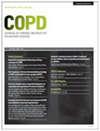有跌倒风险的慢性阻塞性肺疾病(COPD)患者平衡结局的年龄和性别差异
IF 2.2
4区 医学
Q3 RESPIRATORY SYSTEM
COPD: Journal of Chronic Obstructive Pulmonary Disease
Pub Date : 2022-04-07
DOI:10.1080/15412555.2022.2038120
引用次数: 3
摘要
先前没有研究调查了有跌倒风险的慢性阻塞性肺疾病(COPD)患者平衡结果的年龄和性别差异。对正在进行的COPD预防跌倒试验的基线数据进行了二次分析。分析Berg平衡量表(BBS)、平衡评价系统测试(BEST测试)和特定活动平衡置信度量表(ABC)的年龄和性别差异。总共包括223名COPD患者。女性的平衡障碍高于男性[BBS:平均(SD) = 47(8)比49(6)分;BEST测试:73(16)对80(16)分],执行功能活动的置信度较低[ABC = 66(21)对77(19)]。与较年轻(50-65岁)组相比,> - 65岁与平衡控制不良有中度相关性[BBS (r = - 0.37), BEST测试(r = - 0.33)],与ABC量表的相关性较弱(r = - 0.13)。在控制了平衡危险因素的影响后,年龄、基线呼吸困难指数(BDI)和6分钟步行测试(6-MWT)解释了38%的BBS变异性;年龄、性别、BDI和6-MWT解释了BEST测试中40%的变异;BDI和6-MWT解释了ABC量表中44%的变异性。这项研究强调了有跌倒风险的COPD患者在平衡结果上的年龄和性别差异。认识到这些差异对COPD患者的肺康复和预防跌倒具有重要意义,特别是在女性和老年人中。本文章由计算机程序翻译,如有差异,请以英文原文为准。
Age and Sex Differences in Balance Outcomes among Individuals with Chronic Obstructive Pulmonary Disease (COPD) at Risk of Falls
Abstract No previous research has examined age and sex differences in balance outcomes in individuals with chronic obstructive pulmonary disease (COPD) at risk of falls. A secondary analysis of baseline data from an ongoing trial of fall prevention in COPD was conducted. Age and sex differences were analyzed for the Berg Balance scale (BBS), Balance Evaluation System Test (BEST test) and Activities-specific Balance Confidence Scale (ABC). Overall, 223 individuals with COPD were included. Females had higher balance impairments than males [BBS: mean (SD) = 47 (8) vs. 49 (6) points; BEST test: 73 (16) vs. 80 (16) points], and a lower confidence to perform functional activities [ABC = 66 (21) vs. 77 (19)]. Compared to a younger age (50–65 years) group, age >65 years was moderately associated with poor balance control [BBS (r = − 0.37), BEST test (r = − 0.33)] and weakly with the ABC scale (r = − 0.13). After controlling for the effect of balance risk factors, age, baseline dyspnea index (BDI), and the 6-min walk test (6-MWT) explained 38% of the variability in the BBS; age, sex, BDI, and 6-MWT explained 40% of the variability in the BEST test; And BDI and the 6-MWT explained 44% of the variability in the ABC scale. This study highlights age and sex differences in balance outcomes among individuals with COPD at risk of falls. Recognition of these differences has implications for pulmonary rehabilitation and fall prevention in COPD, particularly among females and older adults.
求助全文
通过发布文献求助,成功后即可免费获取论文全文。
去求助
来源期刊

COPD: Journal of Chronic Obstructive Pulmonary Disease
RESPIRATORY SYSTEM-
CiteScore
4.40
自引率
0.00%
发文量
38
审稿时长
6-12 weeks
期刊介绍:
From pathophysiology and cell biology to pharmacology and psychosocial impact, COPD: Journal Of Chronic Obstructive Pulmonary Disease publishes a wide range of original research, reviews, case studies, and conference proceedings to promote advances in the pathophysiology, diagnosis, management, and control of lung and airway disease and inflammation - providing a unique forum for the discussion, design, and evaluation of more efficient and effective strategies in patient care.
 求助内容:
求助内容: 应助结果提醒方式:
应助结果提醒方式:


